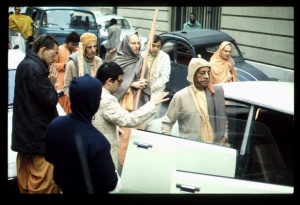SB 3.28.29

A.C. Bhaktivedanta Swami Prabhupada
TEXT 29
- bhṛtyānukampita-dhiyeha gṛhīta-mūrteḥ
- sañcintayed bhagavato vadanāravindam
- yad visphuran-makara-kuṇḍala-valgitena
- vidyotitāmala-kapolam udāra-nāsam
SYNONYMS
bhṛtya — for the devotees; anukampita-dhiyā — out of compassion; iha — in this world; gṛhīta-mūrteḥ — who presents different forms; sañcintayet — one should meditate on; bhagavataḥ — of the Personality of Godhead; vadana — countenance; aravindam — lotuslike; yat — which; visphuran — glittering; makara — alligator-shaped; kuṇḍala — of His earrings; valgitena — by the oscillation; vidyotita — illuminated; amala — crystal clear; kapolam — His cheeks; udāra — prominent; nāsam — His nose.
TRANSLATION
The yogī should then meditate on the lotuslike countenance of the Lord, who presents His different forms in this world out of compassion for the anxious devotees. His nose is prominent, and His crystal-clear cheeks are illuminated by the oscillation of His glittering alligator-shaped earrings.
PURPORT
The Lord descends to the material world out of His deep compassion for His devotees. There are two reasons for the Lord's appearance or incarnation in the material world. Whenever there is a discrepancy in the discharge of religious principles and there is prominence of irreligion, the Lord descends for the protection of the devotees and the destruction of the nondevotees. When He appears, His main purpose is to give solace to His devotees. He does not have to come Himself to destroy the demons, for He has many agents; even the external energy, māyā, has sufficient strength to kill them. But when He comes to show compassion to His devotees, He kills the nondevotees as a matter of course.
The Lord appears in the particular form loved by a particular type of devotee. There are millions of forms of the Lord, but they are one Absolute. As stated in the Brahma-saṁhitā, advaitam acyutam anādim ananta-rūpam: (BS 5.33) all the different forms of the Lord are one, but some devotees want to see Him in the form of Rādhā and Kṛṣṇa, others prefer Him as Sītā and Rāmacandra, others would see Him as Lakṣmī-Nārāyaṇa, and others want to see Him as four-handed Nārāyaṇa, Vāsudeva. The Lord has innumerable forms, and He appears in a particular form as preferred by a particular type of devotee. A yogī is advised to meditate upon the forms that are approved by devotees. A yogī cannot imagine a form for meditation. Those so-called yogīs who manufacture a circle or target are engaged in nonsense. Actually, a yogī must meditate upon the form of the Supreme Personality of Godhead that has been experienced by the Lord's pure devotees. Yogī means devotee. Yogīs who are not actually pure devotees should follow in the footsteps of devotees. It is especially mentioned here that the yogī should meditate upon the form which is thus approved; he cannot manufacture a form of the Lord.